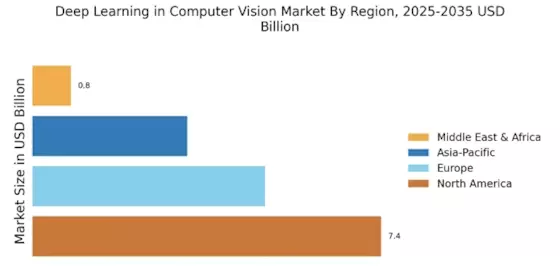Emergence of Edge Computing Solutions
The emergence of edge computing solutions is reshaping the landscape of the Deep Learning in Computer Vision Market. By processing data closer to the source, edge computing reduces latency and bandwidth usage, which is particularly beneficial for real-time computer vision applications. This trend is gaining traction in sectors such as manufacturing, automotive, and healthcare, where timely data processing is critical. The edge computing market is anticipated to grow at a compound annual growth rate of approximately 30% through 2025, indicating a strong shift towards decentralized computing architectures. As organizations seek to enhance operational efficiency and responsiveness, the integration of deep learning in computer vision with edge computing is likely to become more prevalent, driving further market growth.
Integration of AI in Consumer Electronics
The integration of artificial intelligence in consumer electronics is significantly impacting the Deep Learning in Computer Vision Market. Devices such as smartphones, smart cameras, and home automation systems are increasingly incorporating deep learning capabilities for enhanced user experiences. The market for AI-enabled consumer electronics is projected to grow substantially, with estimates suggesting a value of over 300 billion USD by 2025. This growth is driven by consumer demand for smarter, more intuitive devices that can recognize and respond to visual inputs. As manufacturers continue to innovate and embed deep learning technologies into their products, the market for computer vision applications is expected to expand, offering new functionalities and improving overall user satisfaction.
Advancements in Image Processing Technologies
Technological advancements in image processing are significantly influencing the Deep Learning in Computer Vision Market. Innovations in hardware, such as GPUs and TPUs, have enhanced the capabilities of deep learning models, allowing for faster and more efficient image analysis. The market for image processing is expected to grow at a compound annual growth rate of around 15% through 2025, reflecting the increasing reliance on visual data across industries. Enhanced image processing techniques enable applications in various fields, including retail, automotive, and healthcare, where accurate image recognition is crucial. As these technologies evolve, they are likely to drive further adoption of deep learning solutions, thereby expanding the market's reach and applications.
Rising Demand for Enhanced Security Solutions
The Deep Learning in Computer Vision Market is experiencing a notable surge in demand for advanced security solutions. Organizations are increasingly adopting deep learning technologies to enhance surveillance systems, enabling real-time monitoring and threat detection. The market for video surveillance is projected to reach approximately 62 billion USD by 2025, driven by the need for improved safety measures across various sectors. This trend is particularly evident in urban areas, where smart city initiatives are being implemented. The integration of deep learning algorithms allows for more accurate facial recognition and anomaly detection, thereby improving overall security. As businesses and governments prioritize safety, the adoption of deep learning in computer vision is likely to continue its upward trajectory, indicating a robust growth potential in this segment.
Growing Investment in Research and Development
Investment in research and development is a critical driver for the Deep Learning in Computer Vision Market. Companies and academic institutions are allocating substantial resources to explore innovative applications of deep learning in computer vision. This trend is evidenced by the increasing number of patents filed in this domain, which has seen a rise of over 20% in recent years. Such investments are fostering the development of novel algorithms and models that enhance the accuracy and efficiency of computer vision systems. Furthermore, collaborations between tech firms and research organizations are becoming more prevalent, facilitating knowledge transfer and accelerating advancements. As R&D continues to thrive, it is likely to propel the market forward, creating new opportunities and applications.

















Leave a Comment